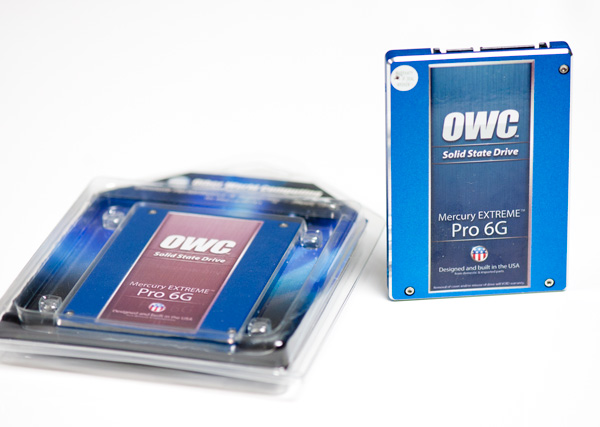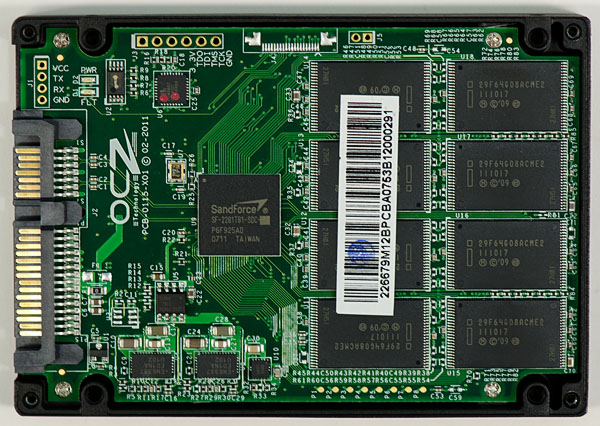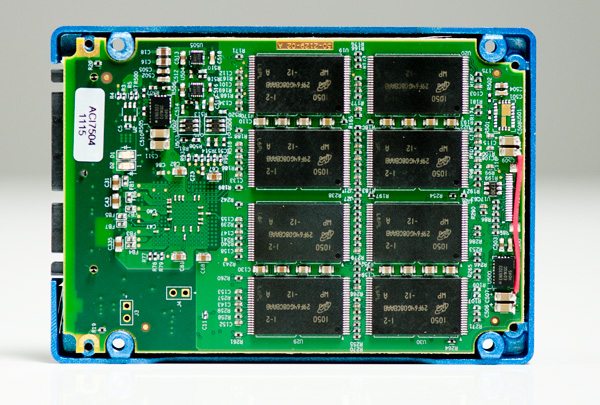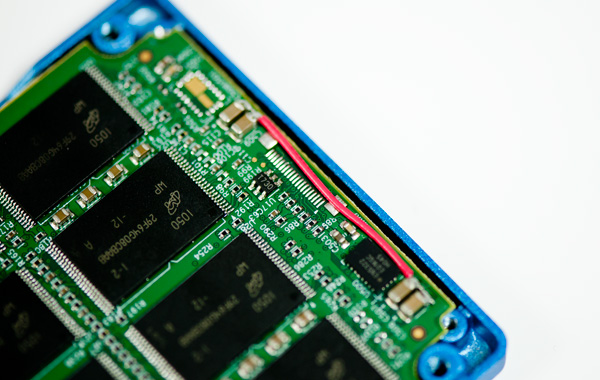OWC Mercury Extreme Pro 6G SSD Review (120GB)
by Anand Lal Shimpi on May 5, 2011 1:45 AM ESTI still don't get how OWC managed to beat OCZ to market last year with the Mercury Extreme SSD. The Vertex LE was supposed to be the first SF-1500 based SSD on the market, but as I mentioned in our review of OWC's offering - readers had drives in hand days before the Vertex LE even started shipping.
I don't believe the same was true this time around. The Vertex 3 was the first SF-2200 based SSD available for purchase online, but OWC was still a close second. Despite multiple SandForce partners announcing drives based on the controller, only OCZ and OWC are shipping SSDs with SandForce's SF-2200 inside.
The new drive from OWC is its answer to the Vertex 3 and it's called the Mercury Extreme Pro 6G. Internally it's virtually identical to OCZ's Vertex 3, although the PCB design is a bit different and it's currently shipping with a slightly different firmware:

OWC's Mercury Extreme Pro 6G 120GB
Both drives use the same SF-2281 controller, however OCZ handles its own PCB layout. It seems whoever designed OWC's PCB made an error in the design as the 120GB sample I received had a rework on the board:
Reworks aren't uncommon for samples but I'm usually uneasy when I see them in retail products. Here's a closer shot of the rework on the PCB:
Eventually the rework will be committed to a PCB design change, but early adopters may be stuck with this. The drive's warranty should be unaffected and the impact on reliability really depends on the nature of the rework and quality of the soldering job.
Like OCZ, OWC is shipping SandForce's RC (Release Candidate) firmware on the Mercury Extreme Pro 6G. Unlike OCZ however, OWC's version of the RC firmware has a lower cap on 4KB random writes. In our 4KB random write tests OWC's drive manages 27K IOPS, while the Vertex 3 can push as high as 52K with a highly compressible dataset (39K with incompressible data). OCZ is still SandForce's favorite partner and thus it gets preferential treatment when it comes to firmware.
OWC has informed me that around Friday or Monday it will have mass production firmware from SandForce, which should boost 4KB random write performance on its drive to a level equal to that of the Vertex 3. If that ends up being the case I'll of course post an update to this review. Note that as a result of the cap that's currently in place, OWC's specs for the Mercury Extreme Pro 6G aren't accurate. I don't put much faith in manufacturer specs to begin with, but it's worth pointing out.
| OWC Mercury Extreme Pro 6G Lineup | |||||
| Specs (6Gbps) | 120GB | 240GB | 480GB | ||
| Sustained Reads | 559MB/s | 559MB/s | 559MB/s | ||
| Sustained Writes | 527MB/s | 527MB/s | 527MB/s | ||
| 4KB Random Read | Up to 60K IOPS | Up to 60K IOPS | Up to 60K IOPS | ||
| 4KB Random Write | Up to 60K IOPS | Up to 60K IOPS | Up to 60K IOPS | ||
| MSRP | $319.99 | $579.99 | $1759.99 | ||
OWC is currently only shipping the 120GB Mercury Extreme Pro 6G SSD. Given our recent experience with variable NAND configurations I asked OWC to disclose all shipping configurations of its SF-2200 drive. According to OWC the only version that will ship for the foreseeable future is what I have here today:
There are sixteen 64Gbit Micron 25nm NAND devices on the PCB. Each NAND device only has a single 64Gbit die inside, which results in lower performance for the 120GB drive than 240GB configurations. My review sample of OCZ's 120GB Vertex 3 had a similar configuration but used Intel 25nm NAND instead. In my testing I didn't notice a significant performance difference between the two configurations (4KB random write limits aside).
OWC prices its 120GB drive at $319.99, which today puts it at $20 more than a 120GB Vertex 3. The Mercury Extreme Pro 6G comes with a 3 year warranty from OWC, identical in length to what OCZ offers as well.
Other than the capped firmware, performance shouldn't be any different between OWC's Mercury Extreme Pro 6G and the Vertex 3. Interestingly enough the 4KB random write cap isn't enough to impact any of our real world tests.
The Test
| CPU | Intel Core i7 965 running at 3.2GHz (Turbo & EIST Disabled) Intel Core i7 2600K running at 3.4GHz (Turbo & EIST Disabled) - for AT SB 2011, AS SSD & ATTO |
| Motherboard: | Intel DX58SO (Intel X58) Intel H67 Motherboard |
| Chipset: | Intel X58 + Marvell SATA 6Gbps PCIe Intel H67 |
| Chipset Drivers: | Intel 9.1.1.1015 + Intel IMSM 8.9 Intel 9.1.1.1015 + Intel RST 10.2 |
| Memory: | Qimonda DDR3-1333 4 x 1GB (7-7-7-20) |
| Video Card: | eVGA GeForce GTX 285 |
| Video Drivers: | NVIDIA ForceWare 190.38 64-bit |
| Desktop Resolution: | 1920 x 1200 |
| OS: | Windows 7 x64 |














44 Comments
View All Comments
Concillian - Thursday, May 5, 2011 - link
This is why I won't buy a SandForce SSD. Yeah, I can get a brand that doesn't have a cap. Or I can go with a different SSD that doesn't force me to jump through hoops to make sure I'm the same hardware from the right vendor.
The same hardware from different vendors should not have vastly different performance. How many people would put up with a memory bandwidth limit on P67 chipset motherboards from Gigabyte, but not ASUS? (or whatever brands.) No memory bandwidth doesn't have a huge impact on overall PC performance, but I think it would still be a big deal if something like that actually happened.
The SF-2281 either needs all vendors capped or none. It's a really shady tactic to offer two versions of the same hardware IMO.
semo - Thursday, May 5, 2011 - link
Nobody in the know likes the SF games but the whole thing is so complicated that most people won't understand it. Suits OCZ as the recent bad publicity doesn't seem to have affected them and everyone thinks they are the best choice for SSDs.Where are the Corsair force GT drives? Also, why are there no reviews of the Samsung 470?
Mr Perfect - Thursday, May 5, 2011 - link
I agree. If you want to offer vendors special products, fine, but give them a different model number. Call a controller capable of 27k a 2280 and the 52k version the 2281. You can still have incentive products, but the consumer doesn't get duped. Everyone's happy.Flunk - Thursday, May 5, 2011 - link
Almost all IC vendors do this. Intel is probably the worst by far. Selling essentially the same chip up to 50 different ways but lasering off parts of it. Almost all onboard sound chips, network chips, drive controllers, GPUs and anything else you can think of uses the same strategy.Chloiber - Thursday, May 5, 2011 - link
So the huge IOPS are pretty much useless, if the QD needs to be high - which is the case with every SSD.Anand, how is the "burst" rate of the Mercury regarding Random Write IOPS? I remember that with SF 12xx, the burst rate was exactly the same (for some seconds), only after 5-20s you could see a difference between the "unlocked" Vertex 2 and the rest. Considering how often one needs the random write performance for several seconds or even minutes (= never) I still think those huge IOPS numbers and the "unlocked firmware" stuff are just a huge marketing stunt. The benefit for the "normal" home user is = zero.
semo - Thursday, May 5, 2011 - link
Why is a high IOPS figure useless? Just because average Joe facebook doesn't do continuous IO intensive operations doesn't mean we don't need fast SSDs. You can apply your "logic" to CPU, GPU and pretty much any other technological advancement.kmmatney - Thursday, May 5, 2011 - link
For the normal home user, the Anand light workload test is really the best thing to look at - no need to look at any other metric. The drive does really well here.Robear - Thursday, May 5, 2011 - link
I believe most people who are interested in the power consumption are most interested in how it performs in a notebook. 2W versus 7W in power is negligible on a desktop. Instead of using a Velociraptor, can you please compare the SSD to a notebook hard drive, like maybe a Seagate Momentus?krazyderek - Thursday, May 5, 2011 - link
the momentus XT is included, the XT was a little more power hungry then typical notebook drives, have a look at the past review for more info to comparehttp://www.anandtech.com/show/3734/seagates-moment...
looks like some the new round of SSD's forgo power savings to move up the performance latter (ie: 240gb OCZ V3)
mschira - Thursday, May 5, 2011 - link
I was wondering if one could fit this drive into a 7mm slimline slot such as the Lenovo T420s.Lenovo only offers an Intel 160gb drive but I would fancy the possibility to insert a speedier 240gb SSD. maybe when removing some of the casing?
cheers
M.